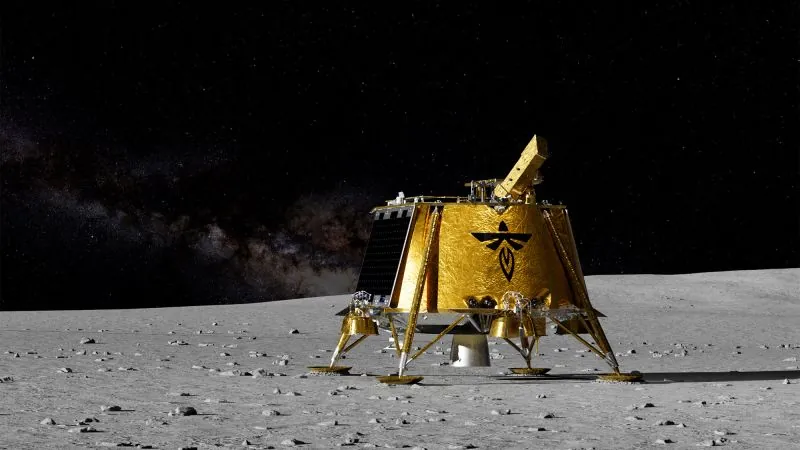
The Thrilling New Moon Race: Countdown to Bold Lunar Missions in 2025!
2025-01-14
Author: Lok
The Race to the Moon: A Revived Lunar Exploration
The unfolding narrative of a revived lunar space race is captivating journey enthusiasts and scientists alike. Following a series of ambitious yet often failed attempts by various nations and private companies to land on the moon, 2025 is set to be a groundbreaking year for lunar exploration, with both seasoned players and fresh contenders stepping up to the challenge.
The excitement begins this January as SpaceX prepares for a monumental launch. A Falcon 9 rocket is slated to carry dual lunar landers developed by Firefly Aerospace from Cedar Park, Texas, and Japan's Ispace. This will mark Firefly's inaugural attempt at a moon landing while Ispace seeks redemption after its previous lander crash-landed in 2023.
These two landers are just the tip of the iceberg. The coming months are packed with groundbreaking uncrewed missions poised to reach the lunar surface. The United States and its collaborators, alongside China, are racing to deploy robotic explorers—a stepping stone towards the eventual return of astronauts to the moon planned by NASA in 2027.
Kicking Off: Dual Launch for Firefly and Ispace
Scheduled for liftoff at 1:11 a.m. ET on Wednesday from NASA's Kennedy Space Center in Florida, the SpaceX Falcon 9 will deploy Firefly's Blue Ghost and Ispace's Resilience landers. The Blue Ghost will embark on a 45-day journey to Mons Latreille, an ancient volcanic feature located in Mare Crisium, also known as the "Sea of Crises." This site promises to unveil critical insights about the moon's geological history and interactive processes with solar wind.
Firefly's Blue Ghost will host innovative experiments, including a "Lunar PlanetVac" for soil sample collection, navigation satellites, and high-tech radiation-resistant computers. The lander is set to operate for about 14 days before enduring the icy constraints of the lunar night.
In contrast, Ispace's Resilience will take a more cautious approach, targeting a landing four to five months post-deployment. This upgraded Hakuto-R lander carries a small, innovative rover equipped with instruments aimed at exploring algae-based food production and monitoring deep-space radiation. Resilience will aim for Mare Frigoris, the "Sea of Cold," located in the moon's northern reaches.
February: A Second Chance for Intuitive Machines
In February 2024, Intuitive Machines made history with the first U.S.-made lunar lander touchdown in over half a century. Despite a difficult landing due to navigational errors, the company is set to attempt a second landing with its new Nova-C lander, Athena. This mission will target the moon's south pole, an area rich in potential water ice. The presence of water could not only support future astronauts with drinking water but could also serve as a resource for rocket fuel.
Athena will carry NASA’s PRIME-1 experiment to drill for water ice and the Lunar Trailblazer satellite, designed to detect water resources from orbit.
Blue Origin Joins the Expedition
Jeff Bezos's Blue Origin is gearing up for its debut of the Blue Moon lunar lander. As one of NASA's chosen vehicles for transporting astronauts from lunar orbit to the moon's surface, Blue Origin holds a vital stake in the space race. The company plans to launch a prototype lander soon, focusing on testing its design and functionality for upcoming missions.
What Lies Ahead: More Missions on the Horizon
Looking beyond these initial launches, exciting lunar missions will continue throughout the year. Intuitive Machines is preparing to kick off its third mission by October, while Astrobotic Technology seeks to rebound from its initial setback last year with its new, larger lunar lander, Griffin. However, the challenges of complex space missions often lead to delays, leaving the timeline uncertain.
Additionally, SpaceX may attempt to dispatch an uncrewed Starship mission, the most powerful spacecraft ever created, as part of its ongoing development efforts—a move that could further help the competition in lunar exploration.
A Race with Global Stakes
As NASA aims not only to bring astronauts back to the lunar surface but also to establish a sustainable presence there, it's clear that this lunar race has both national pride and scientific motivations. China's ambitions to place astronauts on the moon by 2030 intensify the competition, but the larger scientific questions loom: What can the moon tell us about Earth's history, particularly regarding water sources?
As experts like Dr. Bethany Ehlmann point out, understanding the moon’s past holds the key to unraveling the mysteries of Earth's own formation and development. This moon race, while competitive, also serves as a gateway to collective human knowledge and exploration.
Stay tuned, as the lunar landscape is set to change dramatically in the coming years, with technology and persistence paving the way for a new era of discovery!


 Brasil (PT)
Brasil (PT)
 Canada (EN)
Canada (EN)
 Chile (ES)
Chile (ES)
 Česko (CS)
Česko (CS)
 대한민국 (KO)
대한민국 (KO)
 España (ES)
España (ES)
 France (FR)
France (FR)
 Hong Kong (EN)
Hong Kong (EN)
 Italia (IT)
Italia (IT)
 日本 (JA)
日本 (JA)
 Magyarország (HU)
Magyarország (HU)
 Norge (NO)
Norge (NO)
 Polska (PL)
Polska (PL)
 Schweiz (DE)
Schweiz (DE)
 Singapore (EN)
Singapore (EN)
 Sverige (SV)
Sverige (SV)
 Suomi (FI)
Suomi (FI)
 Türkiye (TR)
Türkiye (TR)
 الإمارات العربية المتحدة (AR)
الإمارات العربية المتحدة (AR)